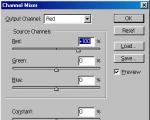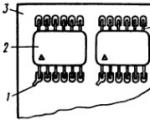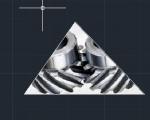5.3 installation of a tripod and assembly of a mobile photoradar. Complexes for measuring the speed of vehicles, photoradar kris-p m. Seal installation and technical documentation

Mobile complex for measuring the speed of vehicles, photoradar « CHRIS » P
2 Purpose and principle of operation
Mobile photoradar (PF) includes a photoradar sensor (PD with built-in battery), a tripod and a battery box. FD is mounted on a tripod andmounted on the side (not between canvases) controlled section of the road, the sensor is oriented relative to the roadway and is connected to the battery box. (Page 6.1 paragraph)
Mobile post (MP) is a laptop with an antenna unit,installed in saloon (not on the roof or outside) stationary patrol car. MP can be located at a distance of up to 1.5 km from a mobile photoradar (in the line of sight) (p. 6, par. 3).
5.2 Selecting an installation location
The controlled section of the road (50-60 meters long), on which the mobile photoradar (PF) will be installed, must bestraight (have no bends, turns or extensions) .(p. 26, paragraph 3)
5.3.1 Setting up the tripod
Install the tripod at a distance H = 3 m from the edge of the carriageway .Maximum allowable distances from the sensor to the roadway for guaranteed license plate recognition:
To control 3-4 lanes - up to 5 meters,
To control 2-3 lanes - up to 9 meters,
To control 1-2 bands - up to 13 meters,
To control 1 lane - up to 17 meters.
ATTENTION : When monitoring the lane for route vehicles, it is recommended to install a tripod at a distanceno more than 1.5 meters from the roadway , preferably opposite the letter« BUT», printed on the strip. Adjust the height of the tripod using the sliding feet and fix with the clamp screws. Recommended sensor installation height -0.5 ... 2 meters from the roadway .(p. 27, par. 4)
5.6 Installing the equipment in the patrol car
Install the antenna unitinside the patrol car (the front side with the sticker should be directed inside the passenger compartment), fixing it on the windshield with a suction cup. Choose the installation location of the AB MP so thatthe block rested on the surface « torpedo » . (p. 31, par. 4)
5.9 Relocation of the patrol car
Orient the PF antenna unit with its working surface towards the intended location of the patrol car. Leave a duty officer next to the photoradar. Move the patrol car with the mobile post to the place of patrol. The mobile post should be located in the line of sight at a distance of up to 1.5 km from the PF.ATTENTION : While on patrol,turn the patrol car so that the working side of the MP antenna unit is directed towards the sensor! (p. 38, par. 1)
6 How it works
6.1 How to work with the program « Violations »
6.1.1 Purpose
Upon the fact of a recorded violation, the traffic police inspector can perform the following actions:
· Write out a handwritten protocol on the violation - in this case, you need to enter the number of the document issued to the violator in the program and close the violation.
· Process the violation on the spot - draw up documents on the case of an administrative offense, print them on a portable printer and hand these documents to the offender immediately.
· Partially process the violation on the spot by filling in the last name, registration address and other data about the offending vehicle and its owner. The final processing of violations, printing and sending of documents are carried out centrally at the central post. (p. 38, par. 4)
8 General operating instructions
It is necessary to take into account the possibility of influencing the operation of a complex of external factors described in the section8 « General operating instructions » . Malfunctions can be caused by:
Devices that are part of the MP, after staying at temperatures below -10° C must be kept under operating conditions for at least 2 hours before use. (p. 62, par. 6)
The presence of powerful electrical interference from power lines , welding installations , lightning discharges , which can lead to both incorrect measurement of the target speed and the impossibility of measuring the speed in general. It is strongly recommended not to install the photoradar sensor closer than 100 meters from the sources of the above interference. (p. 62, par. 8)
Availability switched on discharge lamps on distance less than 5 meters in the direction of operation of the photoradar sensor can create strong interference and make it impossible to measure the speed as a whole. It is recommended to install the photoradar sensor at a distance of more than 5 meters from the switched on gas discharge lamps and not point the sensor at them.
Availability in front of the sensor speed meter large metal objects, even partially covering the control zone , can lead to incorrect speed measurement goals, as well as inability to measure speed generally. (p. 63, paragraph 1)
9 Safety precautions
QATTENTION:
The speed meter and antennas are sources
electromagnetic radiation of ultrahigh frequency range.
Never aim the speed meter and antennas while
radiation per person at close range.
Q It is forbidden to point the switched on photoradar sensor at
large metal objects, from a distance of less than 0.5 meters.
This can lead to failure of the microwave components of the sensor.
QViolation of safety rules when working with radiating
devices may be harmful to health. (p. 64, paragraph 2)
Reading time: 4 minutes Maybe faster ask a lawyer? It's free! print
Private cameras for video recording of traffic violations are currently a legitimate option for holding car owners accountable under the rules of the Code of Administrative Offenses of the Russian Federation. Subject to the rules for installing these controls, the issued decision will be mandatory for the payment of a fine, and in some cases for the imposition of a sanction in the form of deprivation of rights.
Means of video recording of violations on the road can be transferred to private hands on the basis of state contracts concluded between the traffic police service, regional road administrations and legal entities or private entrepreneurs. The subject of these agreements is the operation and ongoing maintenance of video surveillance systems.
The key nuances of such use and placement of surveillance facilities are as follows:
- each complex is subject to verification and certification in accordance with uniform federal rules, and the attendants of private cameras must undergo special training;
- the placement of private complexes on the highways is carried out outside the locations of stationary video surveillance cameras, and their presence should not be indicated by special warning signs;
- the duties of individuals operating video recording cameras include not only identifying violations, but also printing and delivering fines to specific car owners;
- the operation of private cameras is carried out on a reimbursable basis, legal entities and entrepreneurs receive a fixed part of the amount of penalties imposed.
The most common option is to use private video recording equipment on mobile vehicles. In this case, the private owner of the camera has the opportunity not only to record violations, but also to take the necessary measures to protect expensive equipment from illegal actions of third parties. The specified mobile video recording complex can be placed in a hidden or open mode, the law does not establish restrictions on this matter.
As a rule, these complexes are designed to detect speed violations. Video recording complexes designed for these purposes can be purchased under the state order by the road management service, or by private companies. In the second case, the owner of the camera must go through the procedure for checking and certifying the equipment, after which an operating contract can be drawn up.
The accuracy of measuring the speed of vehicles directly depends on the positioning of the camera on the ground. The normative error of private complexes is about 2 km / h, which is a sufficient indicator according to the norms of the Code of Administrative Offenses of the Russian Federation (as you know, the permissible excess of the speed limit under the action of restrictive road signs is up to km / h). At incorrect installation or the operation of a video recording camera, the error can reach 7 km / h, which can significantly violate the interests of car owners.
Challenging decisions made on the basis of data from private video recording cameras takes place according to general rules. The specified document must be sent to the violator, after which a complaint can be filed with the judicial authority within ten days. The procedure for contesting in this case is extremely difficult for the following reasons:
- unlike stationary complexes, private cameras can change their location almost daily, which makes it difficult to prove violations when they are installed on the ground;
- at the legislative level, there is no official methodology for checking camera installation angles, which makes it possible for unscrupulous owners of the complex to artificially increase the error rate and increase the number of detected violations;
- information about the current speed limit is entered in software complex manually, which is often accompanied by errors (it is extremely difficult even for experienced lawyers to prove the inconsistency of the entered data with the indicator of the road sign).
The decision to impose a fine indicates the location of the camera at the time the violation was recorded. To challenge traffic violations recorded through private cameras, it is necessary to drive with a DVR along the route with installed traffic signs. Only in this way can it be proved that the calculated indicator of a private video recording camera did not correspond to the permitted speed limit of the road sign. The procedure for holding the owners of private cameras liable for violations of the rules of operation and installation should be provided for by the terms of the contract.
Complexes for measuring the speed of movement of vehicles photoradar "KRIS-P"M (hereinafter complexes) are designed to measure the speed of vehicles in automatic mode.
Description
The operating principle of the complex is based on the Doppler effect. The complex emits a microwave electromagnetic signal. Reflecting from a moving vehicle (TC), this signal acquires a frequency shift (Doppler effect). This signal is received by the velocity meter and fed to a balanced mixer that extracts the frequency of the Doppler shift. The frequency of the latter is determined during subsequent digital processing. The speed of the vehicle is proportional to the magnitude of the Doppler shift.
Structurally, the complex consists of a photoradar unit (hereinafter referred to as FB) and a number of auxiliary devices (battery supply unit, portable tripod, navigation module, mobile post, communication wifi antennas, cables, etc.) The composition of auxiliary devices may change at the request of the consumer.
FB contains radar, video camera, LED Spotlight illumination, processor unit. The optical axis of the video camera coincides with the axis of the radiation pattern of the radar antenna.
The FB is installed on the side of the roadway, at an angle to the direction of movement, while measuring the speed and photographing the vehicle within the entire roadway. The processor built into the FB ensures the control of all FB components, their synchronization, the formation and storage of photo frames with the data entered into them about vehicle speeds, direction of movement, time and date. During operation, several vehicles can simultaneously enter the radar coverage area. The decision to record the fact of speeding and enter information into long-term memory is made automatically, without the participation of the operator. To avoid disputes, video information is not saved when more than one vehicle is detected in the radar coverage area. Long-term memory is implemented on a flash drive, from which information can be transferred to an external server of the "CRYSTAL" type, where it is checked against information bases, further storage and printing of the decision on the offense.
The FB is made in the form of a monoblock in a protective metal case.
The complex is designed to work when installed on fixed supports and is equipped with an easily removable tripod for rapid deployment.
The requirements for the installation parameters of the complexes are given in the Operation Manual GDYAK468784.019 RE, section 5.
The complex is set up using a mobile post, which is a laptop installed motionless in the cabin standing car. The mobile post also provides the ability to view in real time the violations recorded by the complex and sound notification when a violation is recorded.
The general view of the complex is shown in Figure 1.
The general view and place of filling of the FB complex is shown in Figure 2.
Software
The built-in software is designed to control the radar and video camera, determine the speed of the vehicle and process and store the data obtained as a result of the operation of the complex.
Identification data of the software are given in Table. one.
Table 1
The level of protection of software complexes from unintentional and intentional changes corresponds to the level "C" according to MI 3286-2010.
Specifications
Range of measured vehicle speeds, km/h 20 - 250
Limits of permissible absolute measurement error
vehicle speed, km/h ±2
Operating radiation frequency, GG c 24.15±0.10
Speed measurement range, m, not less than 150
Supply voltage range, V 11.5 - 13.0
FB power consumption, W, no more than 100
Time of continuous operation, h, not less than:
When powered by mains power supply 24
When powered by battery pack 8 Operating conditions of use:
Ambient temperature, ° С minus 40 - 50
Relative air humidity at 25 °С, % 98
Atmospheric pressure, kPa 60.0 - 106.7 dimensions photoradar unit, mm, no more than 400*280*250 FB weight, kg, no more than 9.5
Type approval mark
is applied to the title page of the Operation Manual GDYAK468784.019 RE by the method computer graphics and on the body of the FB complex in the form of a sticker.
|
Name |
Designation |
Note |
|
|
1. Complex consisting of: | |||
|
Photoradar unit |
GDYAK 468798.003 | ||
|
battery pack | |||
|
Wi-Fi wireless antenna |
Supplied on request |
||
|
navigation module | |||
|
Mobile post consisting of: Laptop with software; Control module; Antenna block; Transport bag | |||
|
Cable set | |||
|
2. Charger | |||
|
3. Transport box | |||
|
4. Operation manual |
GDYAK468784.019 RE | ||
|
5. Form |
GDYAK468784.017 FO | ||
|
6. Method of verification |
GDYAK 468784.022 MP |
Verification
carried out according to the document GDYAK 468784.022 MP "Complexes for measuring the speed of vehicles, photoradar" KRIS-P "M. Verification Methodology”, approved by the GCI SI FBU “Test-S.-Petersburg” on June 16, 2014.
List of standards used for verification:
Movement speed simulator IS-24/2 (reg. No. 40725-09), speed reproduction range from 10 to 300 km/h, speed reproduction error limits ±0.3 km/h;
Ch3-66 electronic counting frequency meter (reg. No. 9273-85), frequency range from 10 Hz to 37.5 GHz, PG ±5-10-7 Hz.
Information about measurement methods
Given in the Operation Manual GDYAK468784.019 RE, section 6.
Regulatory and technical papers, establishing requirements for complexes for measuring the speed of vehicles using photoradar "KRIS-P"M
1. GOST 8.129-99 “GSI. State Verification Scheme for Measuring Instruments of Time and Frequency”.
2. GOST R 50856-96 “Radar vehicle speed meters. General technical requirements. Test Methods".
4. TU 4278-029-31002820-2014 “Complexes for measuring the speed of vehicles, photoradar “KRIS-P”M modernized. Specifications".
Outside the scope of state regulation of ensuring the uniformity of measurements.
The principles of operation of the KRIS-P radar were discussed at the Public Association "Society for the Assistance to Motorists" - NGO "OSA".The photoradar complex "KRIS" is a special device, the main purpose of which is the automatic fixation of violations of the rules traffic. In addition, a stationary photoradar complex KRIS-S(as well as its modified model - the KRIS-P photoradar mobile complex) can also recognize the license plates of vehicles, run them through the databases of the administrative police and transmit the information received to the posts of the traffic police.
The principle of operation of the KRIS-P (C) radar
Radar KRIS-P is installed, as a rule, not far from the edge of the carriageway on a special tripod. The complex is oriented relative to the roadway in such a way as to cover all lanes at once. The KRIS camera captures the intruder with all the data about him (this is facilitated by the built-in speed meter). The received information is transmitted to the central reception point (often, this is a mobile point of the DPP) or an external computer intended for this, on which special program processes data and forms a database of traffic offenders. In addition to, in fact, processing the received data, using a computer, you can configure the radar and control its main operation parameters, in particular, set the threshold speed and receive some selective data about violators.

It would not be superfluous to note that, unlike similar devices of other models, the KRIS sensor selects targets in the direction of their movement at a fairly large distance. In turn, this greatly expands its capabilities and increases work efficiency.
Data transmission to mobile posts of the DPP and to external computers carried out as usual telephone line, and cellular communication GSM. Also, the KRIS-P device is capable, thanks to the built-in module, of transmitting information about the intruder via a radio channel. All data transmitted by the sensor is reliably protected by the built-in security system.
KRIS-P (S) specifications radar, instruction
Technical characteristics of KRIS-P are as follows:

Range of speed measurement - 150 m, Range of measured speeds from 20 to 250 km/h, measurement error KRIS-P ± 1 km/h. The maximum range of visual identification of the GRZ of the vehicle by a photographic image at illumination of at least 50 lux in the control zone up to 100 m, less than 50 lux with infrared illumination - 50 m. The maximum range of data transmission via radio channel is 1.5 km, the maximum range of infrared illumination is 50 m. Maximum the number of frames stored on the sensor's flash drive (2 GB) - at least 9000 frames. Permissible operating time from a battery with a capacity of 55A * h is at least 8 hours. The error of the non-volatile clock is not more than 2 seconds per day. Operating conditions of use: ambient temperature from -30 to +50 °С, relative humidity up to 90% at +30 °С, atmospheric pressure from 60 to 107.6 kPa. The average service life before decommissioning is at least 6 years. Calibration interval 2 years.
CRIS Defense and Appeal: The Impossible is Possible!
No matter how high-quality and accurate the photo-radar mobile complex "KRIS-S" would be, many special devices have already been released today that allow you to warn the owner of the vehicle about approaching the recording facility. The radar detector for CRIS, regardless of the model and manufacturer, is able to fix the location of the post with the speed meter installed and warn the driver about approaching it. As a rule, a warning occurs with the help of a sound signal and after it sounds, the driver has the opportunity to slow down or go around the post by another road, since the range of the radar detector is quite large.
It should be noted that today not every anti-CRIS radar detector on the domestic market is able to effectively cope with its intended purpose. Some, as car owners complain, cannot register the presence of a radar on the road in time, while others, although they warn the driver, it is too late when the registration device took a picture and recorded the speed of movement. How to cheat KRIS P? To date, radar detectors of some models have proven themselves well in the fight against the KRIS-P speed meter. According to the reviews of car owners who have installed such devices, they quite effectively cope with their intended purpose and warn in time about the presence of the KRIS system on the roadway.
Since last year, KRIS-P mobile photoradar systems have been operating in Kazakhstan. During this time, with their help, thousands of reckless drivers on the roads were identified. But it turns out that not all pictures taken by such photoradar are legal.
Mikhail Klenchin
Well-known Kazakh lawyer Mikhail Klenchin posted on his page Facebook information on how the KRIS-P photoradar should actually work.
“An interesting document has come into my hands,” the lawyer writes. – Operating instructions for the KRIS-P photoradar. The one that causes so many questions and indignation of motorists.
First, about the civilians operating the photoradar. The instruction says:
"The KRIS-P complex is a complex technical means, to work with which the inspector staff of the traffic police, who has studied this manual operating manual and instructed.
Nevertheless, I believe that the facts of the discovery of “incomprehensible” civilians with CRIS are nothing more than cases of setting it up for transfer to the customer, that is, directly to the traffic police. However, if at least one case is revealed when a violation is imputed based on the results of work with a photo radar of unauthorized civilians, this is a violation of the operating rules and a basis for challenging the imposed penalty.

This is what a camera looks like
As for the installation site of the photoradar, paragraph 5.2 of the Instructions directly states: “The controlled section of the road (50-60 meters long) on which the mobile photoradar (PF) will be installed must be straight (do not have bends, turns or extensions).”
That is, because of the angle, "radar" is not allowed
Here is another interesting point: “The complex can simultaneously control no more than 2 lanes in one direction (i.e. either the 3rd and 4th lanes, or the 2nd and 3rd lanes, or the 1st and 2nd lane). I would also note paragraph 5.3.1 of the Instruction “Installing a tripod”, which regulates the maximum allowable distances from the sensor to the roadway: - for monitoring 3-4 lanes - up to 5 meters,
– for control of 2-3 lanes – up to 9 meters,
– for control of 1-2 lanes – up to 13 meters,
- to control 1 lane - up to 17 meters. This means that
and, accordingly, the basis for checking the legality of the imposed penalty. And this is very important. The instruction in clause 5.4.1 “Photo fixation mode” states that the border must be visible in the frame!
If you have been sent a photograph in which the border is not visible, you should know that the photo fixation was made in violation of the requirements of the instructions and such evidence should be recognized as inadmissible.
This is how the KRIS-P photoradar works
And finally, I note that section 6 of the Instruction provides for the possibility of editing and deleting records in the database (yes, yes!):
“To edit information about a vehicle in the database, you must select the appropriate line in the table and click the Edit button. To delete records from the database, select the appropriate line in the table and click the Delete/Revert button.
Something like that. Draw your own conclusions.
Unfortunately, we do not have a regulatory legal act that directly regulates the procedure for using photoradar, there is only this instruction.





